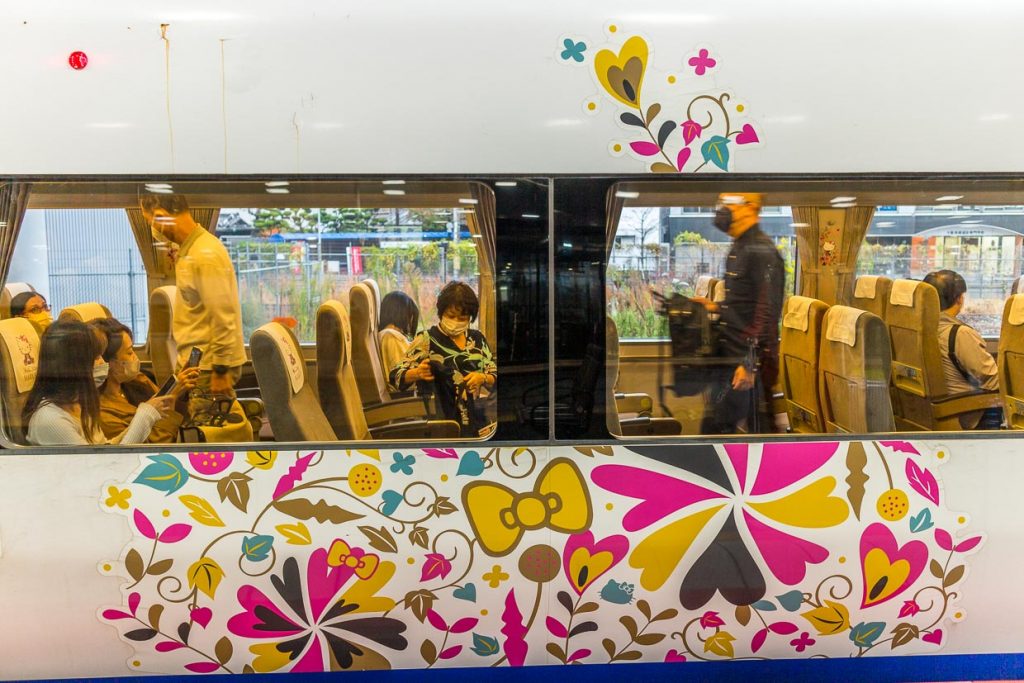A lot of things in Japan are kawaii – that is, cute. Kawaii is an expression of pop culture and at the same time an ideal of beauty. Kawaii means being cool and trendy. Kawaii has big eyes and a narrow mouth, just like the heroes in manga and anime series. Once you understand the meaning of kawaii, you’ll find the Japanese penchant for cuteness, which started in the 1970s, everywhere. Even airplanes, trains or park benches are available in the kawaii look. Especially popular and successful on the road are Hello Kitty or Heidi, whose fan base spans generations and consists of more than just little girls.

Hello Kitty, pop culture icon
Hello Kitty and her pink world are created in 1974 on the sketchpad of designer Yūko Shimizu. Since then, several generations of Japanese girls and boys have grown up with the little kitten. A whole industry of mass-produced articles has grown up around Hello Kitty. The rights holder to Hello Kitty is the entertainment company Sanrio. The world of Hello Kitty has long since ceased to be limited to small merchandising items such as notepads, pens or socks. While in Germany it is often only the parents of little girls who go through a pink phase, Hello Kitty and her big-eyed companions like the manga hero Naruto or Heidi are omnipresent in Japan. With a growing and cross-generational fan base, the projection screens for the cute kitty have also become larger and larger.



The pink Shinkansen
The Japanese bullet train Shinkansen has been speeding across Japan’s rail network with enviable precision for more than 50 years. In 2018, a pink-and-white-painted Shinkansen has hit the rails with Hello Kitty seats, its own arrival melody and plenty of interior gadgets. The train’s maiden voyage is being covered by the media, like a superstar’s tour. In 2019, a Hello Kitty express train from JR West will begin its journey between Kansai-Osaka Airport and Kyoto. Whether you catch one of the few Hello Kitty trains is purely a matter of luck, as the travel times of the popular kitty trains vary daily.

Kawaii in everyday life
Gray and unadorned they come along, are not appreciated a glance and usually one tramples carelessly over them. Not so in Japan. Here, manhole covers are an ornament in public spaces. They are small works of art that depict historical scenes, landmarks or mascots of a city. Thousands of these graphically designed manhole covers can be found all over Japan. The growing fan community has already organized itself and is issuing trading cards with geo-data and background information on the motif. So it’s worth directing your wondering gaze to the ground as well on a trip to Japan.


Taken off. Hello Kitty plane from EVA Air
Taiwanese airline EVA Air has been cooperating with the Sanrio Group for years. In Europe, the aircraft with kawaii livery took off for the start of the new Munich – Taipei flight connection. Since November 5, 2022, EVA Air has been flying non-stop from Munich to Taiwan four times a week. The Hello Kitty plane, named Friendship Bows, connects destinations mainly in East Asia, where the Hello Kitty fan community is at home. The aircraft with its kawaii livery only took off for Europe to inaugurate a new flight connection. Since November 2022, EVA Air has been flying four times a week non-stop from Munich to Taipei. From there, EVA Air, which is a member of the Star Alliance and consistently receives top marks for safety, will take travelers on to seven Japanese cities – Tokyo, Okinawa, Fukuoka, Osaka, Sapporo, Sendai and Komatsu. Travelers to Japan can thus take an open jaw flight to the megacity of Tokyo just once and travel directly to another region of Japan on the outbound or return flight. This saves on domestic flights, because within Japan, the excellent rail network takes you to almost every corner of the island nation. With a little luck, you can travel around the country in a Hello Kitty train.

The research took place on a press trip organized by JNTO.

